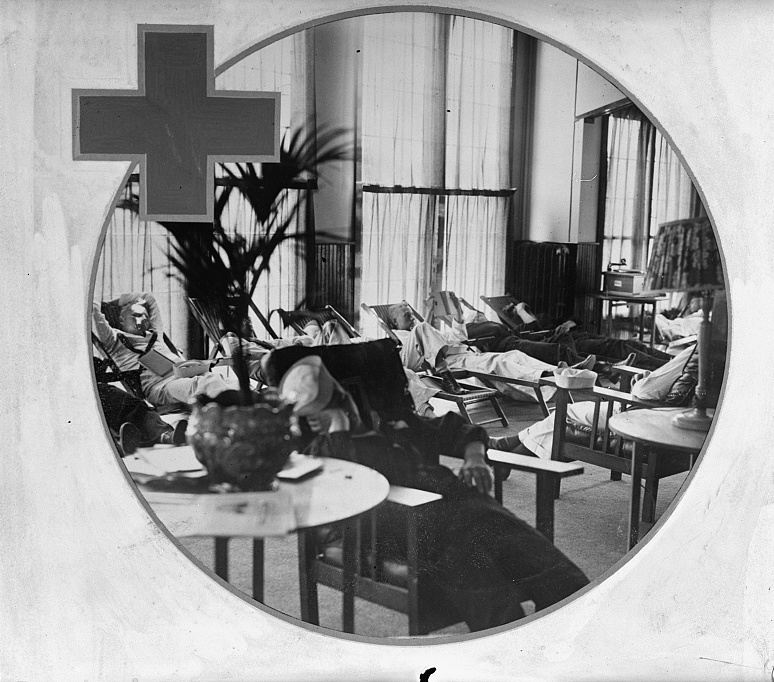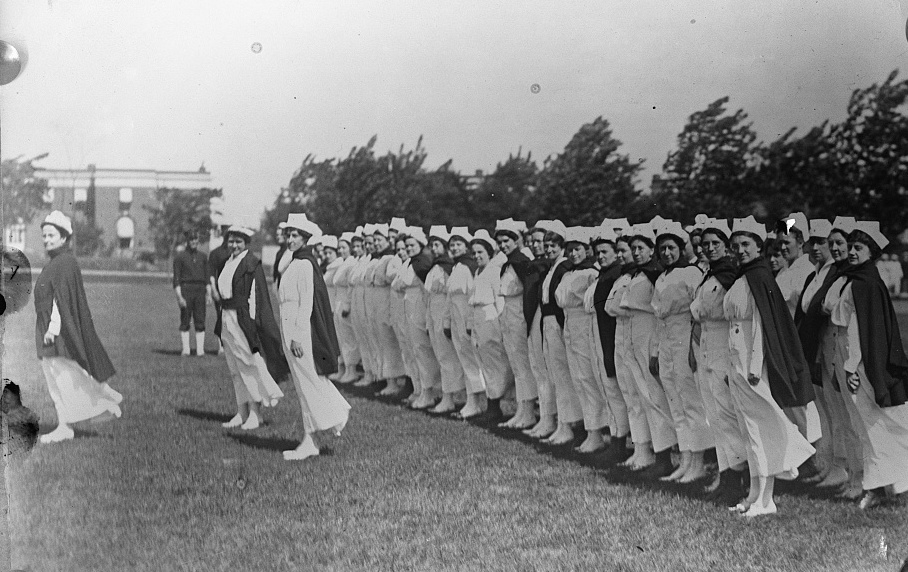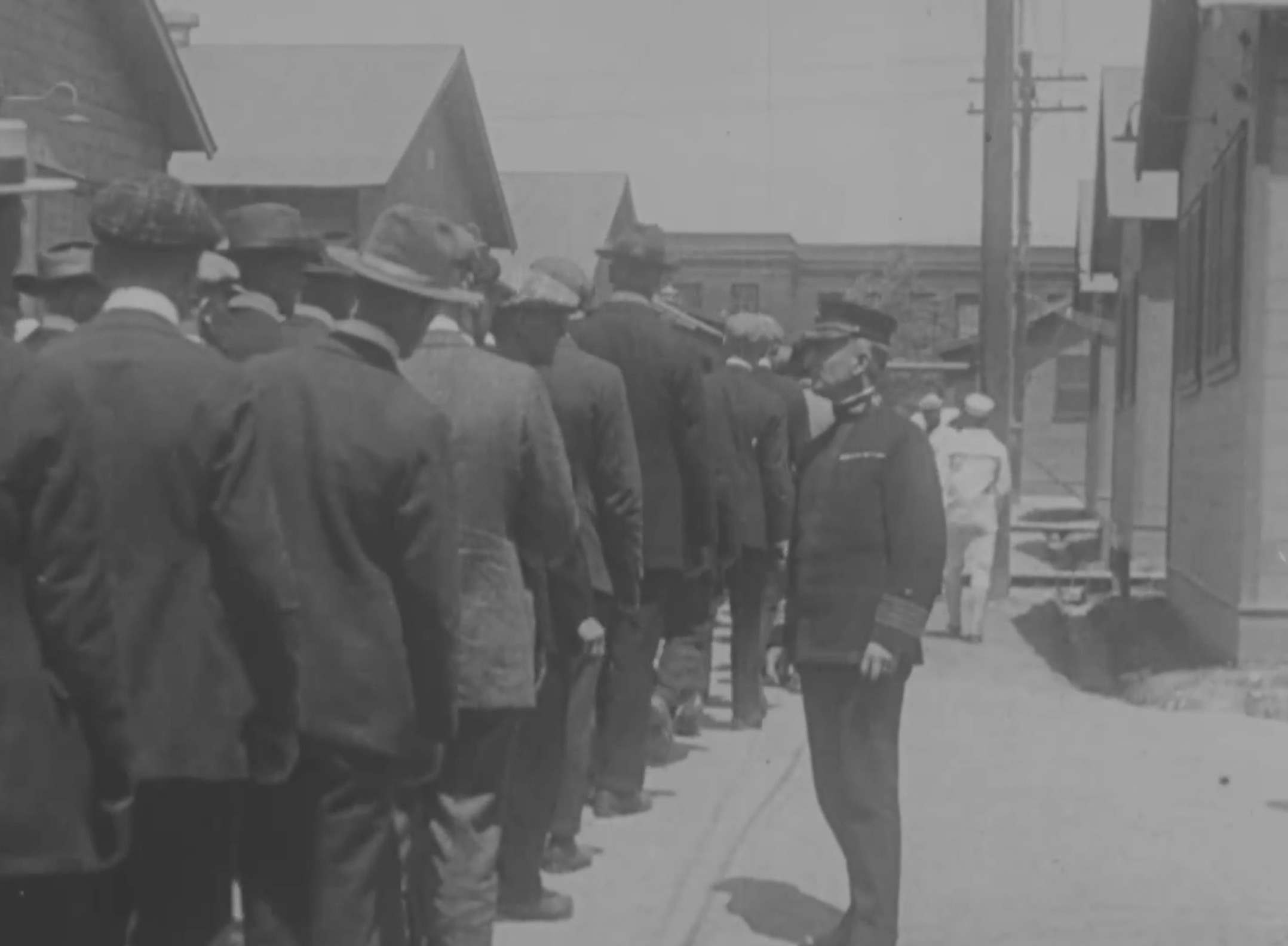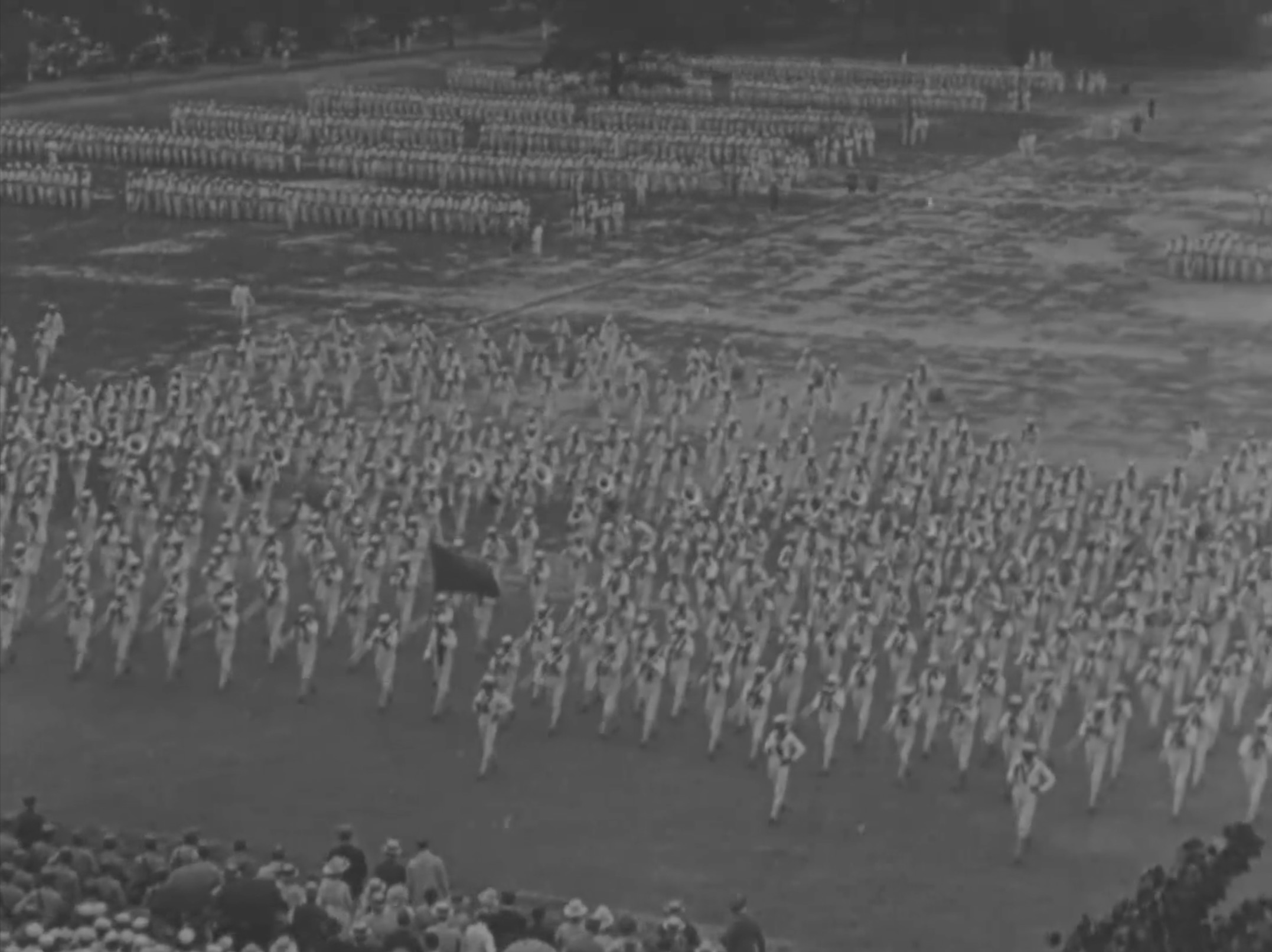By Jeff Nichols
June 17, 2020
This post was originally published by the Chicago Reader and is reprinted here with permission. This is the second post in our series on the 1918 influenza pandemic. Read the other posts in the series here.
In 1918 in the northern suburban fringe of Chicago, an insidious illness killed twice the number of naval personnel in two months than combat did during the entire First World War. The so-called Spanish influenza epidemic swept through Great Lakes Naval Training Station “like the Black Plague,” recalled Martin Birkham, a YMCA volunteer at the training station.[1] The hard choices made at Great Lakes should haunt us today.
Dedicated as a boot camp for naval recruits from throughout the Midwest, Great Lakes Naval Training Station opened in 1911. After the United States declared war against Germany in April 1917, the commandant of Great Lakes, Captain William A. Moffett, was left with only four officers on his staff. New recruits at Great Lakes, like those at other training camps, lived in gold rush conditions, sleeping in tents anchored in muddy fields.
A native South Carolinian, Moffett was a character familiar to Chicago history—the charming out-of-towner turned master insider and big builder. Authorized to enroll officers as naval reservists, Moffett drew the managerial elites from the North Shore and Chicago. A crew of 1,200 enlisted men hammered an average of one thousand pounds of nails a day to build their barracks. From its original 187-acre campus, Great Lakes expanded to over 775 buildings spread over 12,000 acres.
Moffett was especially gifted at public relations. Day-tripping dignitaries, sightseers, and families of recruits routinely visited the Station for concerts, sporting events, air shows, and enormous displays of precision drilling. The press fawned over the Station. “It is not only that faces, throats and arms are tanned to the gleam of precious metal, and that the treasure of youth, divine youth at the zenith of its physical perfection, glistens through the close-fitting summer uniforms, from lithe sinew and resilient muscle, like an incandescent wire blasting through its globe of glass,” wrote the St. Louis Post-Dispatch. [2]
The Great Lakes Naval Revue, which included the budding comedian Benjamin Kubelsky (later known as Jack Benny), played the Midwest theatrical circuit to popular acclaim. The undefeated football team, whose lineup included George Halas, won the Rose Bowl. Barnstorming across the country, John Phillip Souza and his Great Lakes Band Battalion raised tens of millions of dollars for war bonds and war charities, a very handsome turnover of the $40,000 appropriated for band instrument.
These efforts served not only the cause of naval recruitment, but also the mission of instilling discipline and defusing tension with the station’s wealthy neighbors. The station was within walking distance of Waukegan, on the same train line that served the North Shore. In some of the wealthiest neighborhoods in the Midwest, families opened their homes to sailors, who might have been tempted to visit taverns and brothels in Chicago. During their two-day leaves, the “clubs, homes, automobiles and young ladies are at our service,” Leo Bouton, a sailor apprentice, wrote a pen pal.[3] Hundreds of civilians worked as unpaid volunteers within the Station and at naval clubs in their communities.
Great Lakes Naval Training Station in 1918. Capt. William A. Moffett appears inspecting new recruits at the beginning of the footage. National Archives-College Park.
The openness of the training station, which allowed it to thrive as a model city, would be its great weakness. Introduced to Great Lakes by sailors transferring from Boston, influenza was first reported on September 7, 1918. Naval health officers knew that the epidemic would eventually cross the Atlantic, but, as the Surgeon General Navy wrote the distressed health commissioner of Boston, “under war conditions it would have been futile to attempt to quarantine against its introduction into this country.”[4]
Statistically speaking, Great Lakes was probably one of the safest places for any other epidemic. The concern over contagious diseases led Great Lakes to consult an architect of tuberculosis sanitariums. Medical Services at Great Lakes had at its disposal a state-of-the-art hospital staffed with a thousand apprentices enrolled at its Hospital School. Unlike public health officials in the civilian world, the Navy was both willing and able to discipline their charges for the smallest derivations in healthy living. One sailor apprentice, Royal Bauer, recorded in his diary how an officer found a recruit with a grimy neck. He ordered the company to strip and scrub the sailor with hard brushes, soap, and fifty pails of water.
But this epidemic, which effortlessly crossed over quarantined dorms, was unusually lethal to young men and women. Ominously, many hospital corpsmen, even ones wearing gauze masks, became incapacitated while tending to their patients. The labs at Great Lakes worked futilely to isolate the “influenza germ” behind the epidemic.

The training station’s newspaper dubbed influenza “the unwelcome visitor.” Even as the hospital and sick bays filled with sailors, the first week of the epidemic did not inspire terror. “It begins with high fever. Most get real weak and collapse,” sailor apprentice Harney Stover wrote his parents. “I probably will get it. I don’t think I will be very sick.”[5]
Reservists who contracted the flu simply went home to recover. After receiving mandatory nose sprays, hundreds of sailors left on weekend passes for the North Shore. Stover, who left the Station on leave after helping sick mates, believed the iodine nose spray protected him from infection. “The sailors who have been about Waukegan during the past few days have been sneezing and coughing and buying ‘dope’ for their noses and throats,” commented the Waukegan Daily Sun.[6]
Great Lakes Naval Training Station became the beachhead of the epidemic in Illinois. Like a number of medical experts at the time, the command at Great Lakes maintained that influenza was spread in indoor gatherings and poorly ventilated rooms, but not “in the open.” [7] By the time Great Lakes rescinded liberty for unlisted men on September 19, ten percent of the training station had reported ill with influenza.
In the press, the training station worked hard to present optimistic news about the epidemic. Contrary to his own clinical findings, the Station’s chief medical officer, Lt. Owen J. Mink, informed reporters that 95-98 percent of his influenza cases were mild.[8] Mink admitted that there were 4,500 total cases of influenza, one thousand of them serious, with one hundred deaths. With the math supplied—one hundred sailors lost from a population of 46,000—the Tribune concluded that the death rate was “comfortingly low in consideration of the wide sweep of the disease.”[9]
The Chicago Evening Post reasoned that Great Lakes must have the epidemic under control, as it still welcomed visitors. “None would even think the station is quarantined,” wrote Harney Stover to his parents.[10] On September 21, Chicago lawyer Oscar Miller had dinner at Great Lakes with an officer. In his diary, he painstakingly detailed lunch menus, but made no mention of influenza, despite the fact that 931 sailors were added to the sick list that very day. Only at the peak of the epidemic did Great Lakes cancel highly popular public review of marching bands and precision drilling.
Although newspapers paid homage to individual sailors that had died at Great Lakes, the harrowing climb in the number of deaths due to pneumonia and other influenza-related complications received scant attention. “The people on the outside dont get the news & happenings as they really are, they dont publish them as they figure it discourages & makes the relatives of the enlisted men here feel uneasy as no doubt it does,” Leo Bouton, who had recovered from the flu, confided in a letter that slipped through the censor.[11] Though Lt. Mink warned that people in cities should remain at home and avoid crowded indoor facilities other than the workplace, the scope of the epidemic’s lethality was not readily apparent to those communities that had not yet witnessed its effects. “I do not feel much alarmed about the Spanish Influenza,” banker Rufus Dawes wrote his brother. “It will take its toll on the old and the weak.”[12]
Overwhelmed with panicked relatives at its gates wanting to know about men in quarantine, the command at Great Lakes had reason to fear the true dimensions of the epidemic becoming known. Josie Brown, a recent graduate of nursing school, had read about Spanish influenza in the papers on her way to Great Lakes. After a meal in the cafeteria, the young naval nurse was placed in a ward of 42 desperately ill men, some without beds, some delusional with high fevers.
Josie worked eighteen hours a day. In several instances medical staff “had to be ordered off duty as it was evident that they had overworked and would break down under the physical strain and mental distress that they were suffering,” the Department of the Navy later noted.[13] Seven nurses died at Great Lakes.

There simply was not enough trained medical staff to go around for sailors. Robert St. John, a sixteen-year-old Oak Parker who had lied about his age to join the Navy as means to impress girls, found himself struggling for air for several days. “No one ever took our temperatures and I never even saw a doctor,” he recalled. A friend died next to him.[14]
Katherine Bacigalupo received notice that her son had fallen ill at Great Lakes. After waiting six hours at the hospital along with her sister, she begged a passing chaplain for help. He arranged for a four-minute pass, a rare exception given only for men close to death. Surrounded by dying sailors, Katherine’s son was lying in a drill hall. There were bloodstains on his lips, flies crawling on his face. Returning to the hospital, she demanded that she take her son to Waukegan. The commander of the hospital explained that he would die on the trip and there were no doctors there that could help him. Katherine received word shortly after that her son had died.
“I started to keep a record of the number of deaths at which I was present,” one chaplain wrote, “but found it impossible to continue.” [15] At least eleven morticians worked nonstop shifts, each embalming seven bodies a day. “The morgues were packed almost to the ceiling with bodies stacked one on top on another,” Josie Brown recalled. Even in her sleep she heard the noise of trucks backing up to the morgue. In her dreams, she pictured live sailors being trapped underneath the stacks of dead recruits. [16]
Between September 12 and October 11, 1918, Great Lakes Naval Training Station recorded 9,623 cases of influenza, with 924 deaths. Great Lakes presented half-truths about the epidemic to protect the war effort, which demanded full participation by well-abled young men. Guided by a tragically incomplete understanding of how influenza was transmitted, Moffett and his staff chose not to reveal that Great Lakes Naval Training Station had been the site of heroic failure and lonely death.
If you are appalled by what happened at Great Lakes Naval Training Station, you should consider how history will not only judge the lies told in service of a partisan political war, but also our own self-deceptions in the face of our unwelcome visitor. What has not changed over 102 years is that when hospitals are pushed beyond their capacity during an epidemic, patients and medical staff die cruel deaths.
This article was a condensed version of my undergrad honors thesis, with additional research at National Archives-Washington completed early in grad school. In addition to the secondary literature by Alfred Crosby and John M. Barry on the American experience of the Spanish influenza epidemic, my understanding of the crisis at Great Lakes was informed by reading the station’s own newspaper (the Great Lakes Bulletin), the suburban press, and the six daily mass-circulation newspapers in Chicago.
Jeff Nichols
I am a doctoral candidate in the Department of History at the University of Illinois at Chicago. In 2015, I uncovered lost footage of the Eastland Disaster, which made international news. My dissertation is on the coverage of the First World War in the pages of Chicago newspapers. For more on my work as a public historian, you can visit my website, jeffnicholshistory.com.

